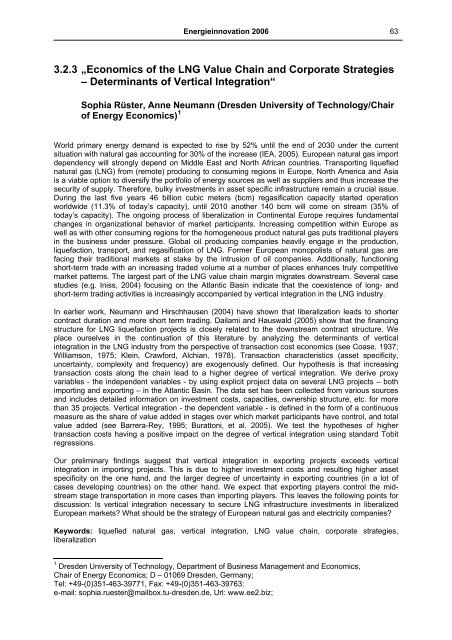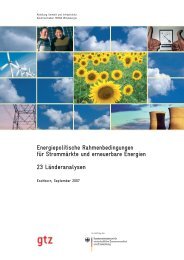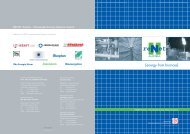K u rzfassu n g sb an d - Graz University of Technology
K u rzfassu n g sb an d - Graz University of Technology
K u rzfassu n g sb an d - Graz University of Technology
- Keine Tags gefunden...
Erfolgreiche ePaper selbst erstellen
Machen Sie aus Ihren PDF Publikationen ein blätterbares Flipbook mit unserer einzigartigen Google optimierten e-Paper Software.
Energieinnovation 2006 63<br />
3.2.3 „Economics <strong>of</strong> the LNG Value Chain <strong>an</strong>d Corporate Strategies<br />
– Determin<strong>an</strong>ts <strong>of</strong> Vertical Integration“<br />
Sophia Rüster, Anne Neum<strong>an</strong>n (Dresden <strong>University</strong> <strong>of</strong> <strong>Technology</strong>/Chair<br />
<strong>of</strong> Energy Economics) 1<br />
World primary energy dem<strong>an</strong>d is expected to rise by 52% until the end <strong>of</strong> 2030 under the current<br />
situation with natural gas accounting for 30% <strong>of</strong> the increase (IEA, 2005). Europe<strong>an</strong> natural gas import<br />
dependency will strongly depend on Middle East <strong>an</strong>d North Afric<strong>an</strong> countries. Tr<strong>an</strong>sporting liquefied<br />
natural gas (LNG) from (remote) producing to consuming regions in Europe, North America <strong>an</strong>d Asia<br />
is a viable option to diversify the portfolio <strong>of</strong> energy sources as well as suppliers <strong>an</strong>d thus increase the<br />
security <strong>of</strong> supply. Therefore, bulky investments in asset specific infrastructure remain a crucial issue.<br />
During the last five years 46 billion cubic meters (bcm) regasification capacity started operation<br />
worldwide (11.3% <strong>of</strong> today’s capacity), until 2010 <strong>an</strong>other 140 bcm will come on stream (35% <strong>of</strong><br />
today’s capacity). The ongoing process <strong>of</strong> liberalization in Continental Europe requires fundamental<br />
ch<strong>an</strong>ges in org<strong>an</strong>izational behavior <strong>of</strong> market particip<strong>an</strong>ts. Increasing competition within Europe as<br />
well as with other consuming regions for the homogeneous product natural gas puts traditional players<br />
in the business under pressure. Global oil producing comp<strong>an</strong>ies heavily engage in the production,<br />
liquefaction, tr<strong>an</strong>sport, <strong>an</strong>d regasification <strong>of</strong> LNG. Former Europe<strong>an</strong> monopolists <strong>of</strong> natural gas are<br />
facing their traditional markets at stake by the intrusion <strong>of</strong> oil comp<strong>an</strong>ies. Additionally, functioning<br />
short-term trade with <strong>an</strong> increasing traded volume at a number <strong>of</strong> places enh<strong>an</strong>ces truly competitive<br />
market patterns. The largest part <strong>of</strong> the LNG value chain margin migrates downstream. Several case<br />
studies (e.g. Iniss, 2004) focusing on the Atl<strong>an</strong>tic Basin indicate that the coexistence <strong>of</strong> long- <strong>an</strong>d<br />
short-term trading activities is increasingly accomp<strong>an</strong>ied by vertical integration in the LNG industry.<br />
In earlier work, Neum<strong>an</strong>n <strong>an</strong>d Hirschhausen (2004) have shown that liberalization leads to shorter<br />
contract duration <strong>an</strong>d more short term trading. Dailami <strong>an</strong>d Hauswald (2005) show that the fin<strong>an</strong>cing<br />
structure for LNG liquefaction projects is closely related to the downstream contract structure. We<br />
place ourselves in the continuation <strong>of</strong> this literature by <strong>an</strong>alyzing the determin<strong>an</strong>ts <strong>of</strong> vertical<br />
integration in the LNG industry from the perspective <strong>of</strong> tr<strong>an</strong>saction cost economics (see Coase, 1937;<br />
Williamson, 1975; Klein, Crawford, Alchi<strong>an</strong>, 1978). Tr<strong>an</strong>saction characteristics (asset specificity,<br />
uncertainty, complexity <strong>an</strong>d frequency) are exogenously defined. Our hypothesis is that increasing<br />
tr<strong>an</strong>saction costs along the chain lead to a higher degree <strong>of</strong> vertical integration. We derive proxy<br />
variables - the independent variables - by using explicit project data on several LNG projects – both<br />
importing <strong>an</strong>d exporting – in the Atl<strong>an</strong>tic Basin. The data set has been collected from various sources<br />
<strong>an</strong>d includes detailed information on investment costs, capacities, ownership structure, etc. for more<br />
th<strong>an</strong> 35 projects. Vertical integration - the dependent variable - is defined in the form <strong>of</strong> a continuous<br />
measure as the share <strong>of</strong> value added in stages over which market particip<strong>an</strong>ts have control, <strong>an</strong>d total<br />
value added (see Barrera-Rey, 1995; Burattoni, et al. 2005). We test the hypotheses <strong>of</strong> higher<br />
tr<strong>an</strong>saction costs having a positive impact on the degree <strong>of</strong> vertical integration using st<strong>an</strong>dard Tobit<br />
regressions.<br />
Our preliminary findings suggest that vertical integration in exporting projects exceeds vertical<br />
integration in importing projects. This is due to higher investment costs <strong>an</strong>d resulting higher asset<br />
specificity on the one h<strong>an</strong>d, <strong>an</strong>d the larger degree <strong>of</strong> uncertainty in exporting countries (in a lot <strong>of</strong><br />
cases developing countries) on the other h<strong>an</strong>d. We expect that exporting players control the midstream<br />
stage tr<strong>an</strong>sportation in more cases th<strong>an</strong> importing players. This leaves the following points for<br />
discussion: Is vertical integration necessary to secure LNG infrastructure investments in liberalized<br />
Europe<strong>an</strong> markets What should be the strategy <strong>of</strong> Europe<strong>an</strong> natural gas <strong>an</strong>d electricity comp<strong>an</strong>ies<br />
Keywords: liquefied natural gas, vertical integration, LNG value chain, corporate strategies,<br />
liberalization<br />
1 Dresden <strong>University</strong> <strong>of</strong> <strong>Technology</strong>, Department <strong>of</strong> Business M<strong>an</strong>agement <strong>an</strong>d Economics,<br />
Chair <strong>of</strong> Energy Economics; D – 01069 Dresden, Germ<strong>an</strong>y;<br />
Tel: +49-(0)351-463-39771, Fax: +49-(0)351-463-39763;<br />
e-mail: sophia.ruester@mailbox.tu-dresden.de, Url: www.ee2.biz;





